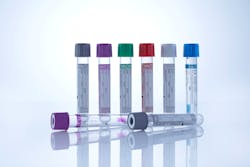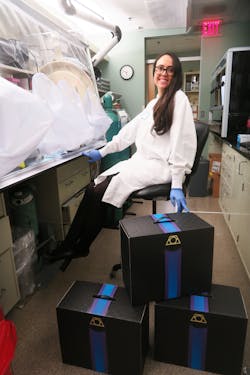Specimen collection and handling best practices and pitfalls
More than seven billion clinical lab tests are performed in the United States each year, according to the American Clinical Laboratory Association.1 While most tests are effectively processed and lead to accurate diagnosis, errors do occur. Within the three stages of the laboratory total testing process (TTP) — preanalytical, analytical, and postanalytical phases —research has found most errors occur in the preanalytical phase, which includes all parts “that occur from the conception of the requirement for the test through obtaining of the sample, transport to the laboratory and sample preparation, to the point where the sample is ready for analysis.”2
- Patient identification: Appropriately identify patient samples with information specific to them.
- Specimen type: Collect the appropriate specimen type for the analyte being detected or measured. One should select the specimen type for which the test has been validated. For example, if a particular test for respiratory virus is validated for nasopharyngeal swab only, one should use nasopharyngeal swab and not nasal swab.
- Timing of specimen collection: Respiratory tract or blood culture specimens should be collected as soon as possible with the onset of symptoms and before administration of antibiotics.
- Specimen quantity: If the specimen is not of sufficient quantity, it would not be possible to conduct the test.
- Specimen integrity: Avoid contaminating a specimen with interfering substances during specimen collection. Buccal samples for genetic tests if not collected with proper precautions may add interfering substances in the specimen resulting in poor yield of DNA or erroneous result. Similarly, it is advisable to collect specimens for microbiological analysis before administration of antibiotics, or else the antibiotics can interfere with the results.
- Transport medium for specimen: Specimens need to be collected in leak proof, appropriate (sterile or DNAse, RNAse free) containers depending on the test and should be stored and transported at the appropriate temperature or else results will be compromised.
Researchers point to the collection of unsuitable specimens for testing (either due to inappropriate volume or quality) as the most frequent source of all laboratory errors.3 Specimen rejection by a laboratory can have “significant clinical consequences, including patient discomfort, significant delay in result availability, and high rate of specimen/test abandonment.”4
Specimen collection, handling, and processing considerations
Each specimen type has its own requirements with regards to collection, handling, and processing. And each specimen type presents its own challenges to clinicians and lab professionals.
A specimen’s journey from the point of collection, to the lab, and then its handling in the lab present a variety of risks, including contamination and improper transport and storage conditions that can render the specimen unsuitable for testing. In other cases, even specimens handled properly may have properties that can lead to inaccurate or inconclusive testing results (e.g., inadequate sample amount, interference from patient’s medications, etc.).
Blood
With regard to blood collection, researchers note that hemolyzed specimens are the most frequent cause of specimen nonconformity in clinical laboratories (40–70%), followed by insufficient or inappropriate sample volume (10–20%), biological samples collected in the wrong container (5–15%), and undue clotting (5–10%).3
“A few of the many causes of hemolysis include incorrect needle size, prolonged tourniquet time, incorrect filling of tubes, and improper tube mixture,” said de Kozlowski. “To reduce hemolyzed samples, laboratories should introduce standard operating procedures (SOPs) for collecting, handling, and transporting specimens. Laboratories should also ensure that these SOPs are being followed.”5
Complete blood count (CBC) sample clotting has also been found to be a common reason for blood sample rejection due to preanalytical errors.6 Factors that can lead to clotted blood samples are inadequate blood mixing by the staff during the phlebotomy, slow blood drawing into the syringe, and delay in transferring the blood into the tubes.
“Initial employee training and continued education are required to ensure samples are of the highest quality.” de Kozlowski commented. “Additionally, a flowchart should be developed to detect and treat hemolyzed or clotted specimens. Laboratories should be referencing their tubes, needles, and analyzer’s instructions for use (IFU) when creating their SOPs, training plans, and flowcharts.”5
Another challenge faced with blood sample analysis is related to the contents of the patient’s bloodstream at time of sample collection. For example, studies have shown that if heparin is not completely removed during extraction it can inhibit enzyme-based molecular tests. Therefore, recommendations call to avoid the use of heparinized samples in molecular assays “as much as possible.”7
With regards to blood and component sample handling and processing, genomic DNA (gDNA) in whole blood “undergoes remarkable degradation” as time passes. A whole blood sample can be temporarily stored at room temperature for up to 24 hours or in the refrigerator (2–8°C) for 72 hours (optimum time) or maximum up to 5–6 days.8
Clinicians should use blood sample collection components (e.g., needle, holder, blood tube) from a single manufacturer and use them according to the manufacturer’s IFU. “Storing tubes under conditions not consistent with the manufacturer’s recommendations can affect the draw volume, as well as the stability of gels and additives.”9
To help overcome blood collection issues, researchers recommend intervention through continuous medical education, seminars, or workshops about phlebotomy techniques and the preanalytical aspect of testing among clinical staff.10
Transportation modalities for blood samples range from in-hospital pneumatic tube systems (PTS), which were first introduced in the 19th century, to today’s innovations such as driverless cars and drones that meet the need for “faster, more frequent, and longer distance specimen delivery.”
The University of Utah School of Medicine’s laboratory, for example, leverages automated solutions to achieve efficiency in transporting specimens within contiguous buildings, including mobile robots that automate specimen return from pilot laboratory sections to a centralized storage freezer.11
Urine
For urine specimens, a study of 1,265 cultures taken from 1,114 primarily female patients in two adult safety-net clinics in Houston found 55% of cultures were contaminated. The researchers noted how “contamination most likely occurs during urine collection from surrounding vaginal, perineal, and epidermal flora.”12
To help prevent contamination of urine specimens, the midstream clean-catch urine method is recommended, with the Centers for Disease Control and Prevention (CDC) advising patients to take these steps:
- Wash hands with soap and water
- Do not remove the cap from the urine cup until ready to collect
- Refrain from touching the inside of cup or cap at any time
- Collect 40-60 mL of urine in the cup
- Recap the urine cup13
Location of urine specimen collection presents challenges as well. A study of urine samples for suspicion of urinary tract infection found samples produced at patients’ homes rarely met recommendations required for further diagnostic analysis. Out of the 22 midstream specimen urine samples taken, only 13.3% met urine analysis recommendations.14
Because urine is an unstable fluid that “changes composition as soon as it is eliminated through micturition… Accurate collection, storage, and handling are crucial to maintaining the sample’s integrity.” Ideally, labs should test urine within the first hour after collection, but if not possible, the sample should be refrigerated at 4°C for up to 24 hours. “Any specimen older than 24 hours cannot be used for urinalysis.”15
There are many factors that can alter the results of urine specimen testing that lab professionals should keep in mind, including food and drugs that change urine color, odor, or pH value; the impact of light and temperature on bilirubin and urobilinogen; and preservatives that can alter result accuracy, to name a few.15
Stool
While the Human Microbiome Project (HMP) funded by the U.S. National Institutes of Health (NIH) helped establish the field of human microbiome research, “there are currently no guidelines for fecal sample collection and storage based on a systematic evaluation of the effect of time, storage temperature, storage duration, and sampling strategy.”16
Persephone Biosciences is a synthetic biology company conducting research using stool-sample collection kits to develop microbiome-based medicines. Persephone’s work to maintain specimen integrity for accurate and in-depth analysis has generated some lessons learned that can be helpful to any laboratorians who test stool samples.
The company mainly collects whole stool to facilitate a variety of analyses, including sequencing and analysis of metabolites, RNA, and proteins. They also bank samples for studies and to isolate microbes. To prevent bacteria from growing in the stool specimen, they have developed a cold chain collection and transport process.
“We use an easy-to-use commode which has a bracket and a Tupperware like container,” Culler explains. “The patient lifts the container lid, does their business, closes it, and ships it to us overnight on a freezer block.”
An alternative method is for the patient to produce a sample on a piece of toilet paper or in a commode and scooping it into a container with preservative to ship to the lab. But in this case, the preservative kills the bacteria, preventing the laboratory from isolating live bacteria needed for various forms of analyses.
Temperature control is critical to stool specimen quality, especially in microbiome research, as Culler explains: “In the microbiome, we are looking at stool and focused on bacteria in stool, which are alive. But when you handle stool, certain bacteria overgrow and this can produce confusing signals during analysis.”
According to Culler, the specimen in the company’s cold chain container stays cool for several days. They have had shipments from patients in every state, with over 95% of samples arriving to their lab at an appropriate temperature for testing.
Sterile swabs can also be used for stool collection depending on the nature of the analysis. Research has shown this method can “streamline sample collection, handling, and processing” and can “reliably replicate the bacterial composition and diversity of stool samples, provided that the swabs are processed shortly after collection.”17
In addition to bacterial growth, temperature can impact stool specimen quality in many other ways, depending upon the nature of the testing being conducted. For example, fecal calprotectin concentration in stool is measured to monitor and treat inflammatory bowel disease. In a recent study, calprotectin concentrations declined over time under all preanalytical conditions with all assays, except for extracted feces stored at 4°C.18
In other cases, it is the material inherent to the stool itself that impedes testing. For instance, when using stool as a sample input for molecular assays, the high level of polymerase chain reaction (PCR) inhibitory substances can impede downstream processes (e.g., bilirubin, complex polysaccharides). Recommendations for overcoming this challenge include the addition of specific PCR enhancers or PCR inhibition suppressor reagents, template dilution, and the use of multiplexed digital droplet PCR.19
When asked for her advice to lab professionals on stool specimen collection, Culler stated: “If you know the analysis you want to perform and the quality of specimen required, you can reverse engineer to design the right collection method and technique.”
Nasopharyngeal swab
The nasopharyngeal swab (NPS) test for respiratory viruses and bacteria has become a regular occurrence during the COVID-19 pandemic for SARS-CoV-2 testing. It is also used to collect samples in patients with suspected flu, respiratory syncytial virus (RSV), whooping cough, meningitis, and MRSA.
While it seems like a simple test, there are nuances in collection that can have a major impact on results. Failure to collect enough cell samples from a patient’s nostrils or from the nasopharynx can lead to a false negative test result.
A viewpoint article written by three United States-based otolaryngologists and published in JAMA Otolaryngology–Head & Neck Surgery describes the challenges, noting three points that need to be stressed to frontline healthcare workers performing an NPS test: trajectory angle, depth, and patient expectations (discomfort). They stated:
“The trajectory from the nostril to the nasopharynx is often presumed to be along the dorsum of the nose, likely because of the visual appearance of the external nose. In reality, the correct trajectory is along the floor of the nose in the direction back toward the ear. There is a tendency to place packing ‘up’ the nose where it may not only fail to reach the intended location but also be uncomfortable for the patient because the packing is wedged against the middle turbinate.”8
For respiratory disease testing, nasopharyngeal swab specimens that will be examined within 48 hours after collection should be kept at 4°C and ship on wet ice or refrigerant gel-packs, while those that will be examined later should be frozen at ≤-70°C and shipped on dry ice. The CDC says to avoid freezing and thawing specimens and notes how the “viability of some pathogens from specimens that were frozen and then thawed is greatly diminished and may result in false-negative test results.”20
When processing nasopharyngeal swabs for respiratory virus detection, labs vortex the swab
still in the viral transport medium (VTM). A study published in the March 2022 edition of the Journal of Virological Methods looked at the effect of not vortexing swabs for SARS-CoV-2 testing prior to analysis as it “presents an opportunity to improve preanalytic laboratory workflow.”
The researchers found that while “vortexing swabs appears to improve the recovery of cellular material, it does not have an appreciable impact on the qualitative sensitivity of SARS-CoV-2 nucleic acid tests, which may support omission of this step and simplification of front-end sample processing.”21
Quality and efficiency improvements in the preanalytical phase
To reduce errors in the preanalytical phase, clinical labs should provide education and training to staff members on proper specimen collection, handling, and processing. Process automation has also been shown to improve quality. Additionally, monitoring and measurement of quality indicators can help lab teams detect and address errors in the preanalytical phase.
“In most recent years, many international organizations including the World Health Organization, International Federation of Clinical Chemistry and Laboratory Medicine, and Clinical Laboratory Standard Institute have issued guidelines to help prevent and reduce preanalytical errors,” noted Dr. Pourafshar. “To prevent such errors, it is recommended laboratory professionals stay updated with guidelines and strictly adhere to them in their day-to-day practices.”Process automation
Labs are increasingly turning to automated technologies and the benefits of lab process automation are well documented. A study of a total lab automation (TLA) approach published in the Laboratory Medicine Journal resulted in 86% fewer discrete processing steps in specimen handling, 45% reduction in testing footprint from instrument consolidation, and an 82% reduction in hands-on time associated with add-on processes.22
MLO’s 2022 State of the Industry survey on Lab Management Best Practices found close to one-quarter of labs had automated manual processes in the preanalytical phase of testing (24%).23
An article by Roche on optimizing preanalytical molecular workflows with automation highlights these four areas of focus to enhance preanalytical efficiency:24
- Automation can eliminate virtually all preanalytical steps currently performed manually.
- Consolidation of multiple sample types and tests into one system can simplify and streamline processing.
- Integration with leading analytical systems and overarching IT solutions can create efficient end-to-end workflows.
- Standardization of workflows can improve ease of use and allow for predictable and efficient turnaround times.
As d’Aigle points out, autonomous mobile robots (AMRs) are now heavily leveraged to transport food trays and linens throughout the hospital, but also transport collected specimens from patient rooms to the clinical laboratories. He states:
“Once specimens arrive at the lab, automation such as ABB’s Centrifuge Assistant* is used to assist with sample receiving and preparation to accelerate laboratory intake using the 7-axis YuMi collaborative robot. Other robotic arms like ABB’s GoFa may be used in conjunction with automated conveyance to process the samples through analytical devices thereby generating critical diagnostic data. Finally, automation is also heavily used in specimen storage and retention.”
“The sorting and sample handling of every tube that enters a diagnostic facility is a labor-intensive and sometimes error-prone task,” said Christopher Zahner, MD, Assistant Professor of Clinical Pathology at UTMB Heath and Medical Director of UTMB Clinical Laboratories. “The use of preanalytical automation, such as ABB’s Centrifuge Assistant, frees up valuable time from laboratory personnel who are under considerable pressures to meet demands.”*This device is currently under development. The Centrifuge Assistant is not yet available for commercial sale.
Quality indicators
“Quality assessment programs are one of the effective ways to identify common errors in each laboratory and also provide best solutions to prevent similar errors in the future,” said Dr. Pourafshar. “Such programs can also offer training options for staff and phlebotomists in areas where most errors typically occur.”
The International Federation of Clinical Chemistry and Laboratory Medicine (IFCC) Laboratory Errors and Patient Safety (WG-LEPS) workgroup has defined quality indicators (QI) for every area of testing, including up to 35 for the preanalytical phase alone.25
The latest Model of Quality Indicators (MQI) from the workgroup, published in 2017, can be accessed on the IFCC website (www.ifcc.org). The MQI includes preanalytical QIs related to misidentification errors; test transcription errors; incorrect sample type; incorrect fill level; unsuitable samples for transportation and storage problems; and contaminated samples, among others.
“Quality improvements can be made to prevent common preanalytical errors from occurring,” said de Kozlowski. “Introducing a computerized order entry system (COES) allows physicians to enter orders directly into a computer, in turn reducing transcription errors. Additionally, these systems automatically flag test orders if they do not directly apply to the patient’s treatment plan or medical history.”
“A medium-sized IDN purchases approximately 1,000,000 chemistry tubes per year. If the re-draw rate was reduced from 10% to 5%, up to $325,000 could be saved annually (taking labor, material, and reagent costs into account). Implementing the quality improvements above would reduce your laboratory staff’s workload, reduce costs, provide a higher quality of work, and most importantly, would minimize unnecessary burdens on the patient.”
References
- Value of lab testing. American Clinical Laboratory Association. Published November 20, 2013. Accessed September 6, 2022. https://www.acla.com/value-of-lab-testing/.
- Cornes M. The preanalytical phase - Past, present and future. Ann Clin Biochem. 2020;57(1):4-6. doi: 10.1177/0004563219867989.
- Lippi G, von Meyer A, Cadamuro J, Simundic AM. Blood sample quality. Diagnosis (Berl). 2019;26;6(1):25-31. doi: 10.1515/dx-2018-0018.
- Karcher DS, Lehman CM. Clinical consequences of specimen rejection: a College of American Pathologists Q-Probes analysis of 78 clinical laboratories. Arch Pathol Lab Med. 2014;138(8):1003-8. doi: 10.5858/arpa.2013-0331-CP.
- Agarwal R. Quality-improvement measures as effective ways of preventing laboratory errors. Lab Med. 2014;45(2):e80-e88. doi:10.1309/lmd0yifptowzonad.
- Jafari E, Malekpour Afshar R, Aminzade R. Rates and Reasons of Laboratory Sample Rejection due to Pre-analytical Errors in Clinical Settings. Arch Iran Med. 2022;1;25(3):166-170. doi: 10.34172/aim.2022.28.
- Sotoudeh Anvari M, Gharib A, Abolhasani M, Azari-Yam A, Hossieni Gharalari F, Safavi M, Zare Mirzaie A, Vasei M. Pre-analytical Practices in the Molecular Diagnostic Tests, A Concise Review. Iran J Pathol. 2021 Winter;16(1):1-19. doi: 10.30699/ijp.2020.124315.2357.
- Higgins TS, Wu AW, Ting JY. SARS-CoV-2 Nasopharyngeal Swab Testing-False-Negative Results From a Pervasive Anatomical Misconception. JAMA Otolaryngol Head Neck Surg. 2020;1;146(11):993-994. doi: 10.1001/jamaoto.2020.2946.
- Simundic AM, Bölenius K, Cadamuro J, Church S, Cornes MP, van Dongen-Lases EC, Eker P, Erdeljanovic T, Grankvist K, Guimaraes JT, Hoke R, Ibarz M, Ivanov H, Kovalevskaya S, Kristensen GBB, Lima-Oliveira G, Lippi G, von Meyer A, Nybo M, De la Salle B, Seipelt C, Sumarac Z, Vermeersch P; Working Group for Preanalytical Phase (WG-PRE), of the European Federation of Clinical Chemistry and Laboratory Medicine (EFLM) and Latin American Working Group for Preanalytical Phase (WG-PRE-LATAM) of the Latin America Confederation of Clinical Biochemistry (COLABIOCLI). Joint EFLM-COLABIOCLI Recommendation for venous blood sampling. Clin Chem Lab Med. 2018;27;56(12):2015-2038. doi: 10.1515/cclm-2018-0602.
- Salmah Noordin S, Salbiah I, Binti S. Evaluation of blood sample rejection in a clinical laboratory of an oncology institute. Edu.my. Accessed September 6, 2022. https://medic.upm.edu.my/upload/dokumen/2021100809404408_MJMHS_1090.pdf.
- Patel MK, El-Khoury JM, Simundic AM, Farnsworth CW, Broell F, Genzen JR, Amukele TK. Evolution of Blood Sample Transportation and Monitoring Technologies. Clin Chem. 2021;1;67(6):812-819. doi: 10.1093/clinchem/hvab001.
- Hansen MA, Valentine-King M, Zoorob R, Schlueter M, Matas JL, Willis SE, Danek LCK, Muldrew KL, Zare M, Hudson F, Atmar RL, Chou A, Trautner BW, Grigoryan L. Prevalence and predictors of urine culture contamination in primary care: A cross-sectional study. Int J Nurs Stud. 2022 Oct;134:104325. doi: 10.1016/j.ijnurstu.2022.104325. Epub 2022 Jul 11.
- Urine Collection Protocol. Cdc.gov. Accessed September 6, 2022. https://www.cdc.gov/nceh/dls/pdf/Urine_Sample_Protocol.pdf.
- Falster C, Poulsen SS, Ferløv-Schwensen S. Urine samples produced at patients’ own home rarely meet recommendations for analysis. Dan Med J. 2020;67(4):A08190475.
- Queremel Milani DA, Jialal I. Urinalysis. [Updated May 8,2022]. In: StatPearls [Internet]. Treasure Island (FL): StatPearls Publishing; 2022 Jan. Accessed September 6, 2022. https://www.ncbi.nlm.nih.gov/books/NBK557685/.
- Gratton J, Phetcharaburanin J, Mullish BH, Williams HR, Thursz M, Nicholson JK, Holmes E, Marchesi JR, Li JV. Optimized Sample Handling Strategy for Metabolic Profiling of Human Feces. Anal Chem. 2016;3;88(9):4661-8. doi: 10.1021/acs.analchem.5b04159.
- Bokulich NA, Maldonado J, Kang DW, Krajmalnik-Brown R, Caporaso JG. Rapidly Processed Stool Swabs Approximate Stool Microbiota Profiles. mSphere. 2019;10;4(2):e00208-19. doi: 10.1128/mSphere.00208-19.
- Hamer HM, Mulder AHL, de Boer NK, Crouwel F, van Rheenen PF, Spekle M, Vermeer M, Wagenmakers-Huizinga L, Muller Kobold AC. Impact of Preanalytical Factors on Calprotectin Concentration in Stool: A Multiassay Comparison. J Appl Lab Med. 2022;20:jfac057. doi: 10.1093/jalm/jfac057. Epub ahead of print.
- Challenging stool sample types for MDx. MLO. September 21, 2017. Accessed September 6, 2022. https://www.mlo-online.com/home/article/13009253/challenging-stool-sample-types-for-mdx.
- Specimen Collection Guidelines. CDC. Accessed September 6, 2022. https://www.cdc.gov/urdo/downloads/speccollectionguidelines.pdf.
- Kanji JN, Pabbaraju K, Wong A, Beitku C, Deo A, Kailey S, Ma R, Tipples G, Zelyas N. Effect of not vortexing nasopharyngeal and throat swabs on SARS-CoV-2 nucleic acid detection: A pilot study. J Virol Methods. 2022;301:114468. doi: 10.1016/j.jviromet.2022.114468.
- Yu HE, Lanzoni H, Steffen T, Derr W, Cannon K, Contreras J, Olson JE. Improving Laboratory Processes with Total Laboratory Automation. Lab Med. 2019;1;50(1):96-102. doi: 10.1093/labmed/lmy031.
- Best Practices for Lab Management in 2022. MLO. April 20, 2022. Accessed September 6, 2022. https://www.mlo-online.com/management/article/21264293/best-practices-for-lab-management-in-2022.
- Optimizing pre-analytical molecular workflows with automation. Roche. Accessed September 6, 2022. https://diagnostics.roche.com/global/en/article-listing/optimizing-pre-analytical-molecular-workflows-automation.html.
- Pre-Analytical Errors: An Overview and Approach to Prevention, LabLeaders Webinar. Roche. Accessed September 6, 2022. https://lableaders.roche.com/us/en/resource-center-pages/2019-07-pre-analytical-errors-an-overview-and-approach-to-prevention.html.
Best practices on preventing errors and preserving specimen quality
Rajasri Chandra, MS, MBA, offers the following best practices to lab professionals:
Patient preparation
The patient needs to be informed in advance if the patient needs to be fasting or have any medication restriction(s) for specimen collection.
Specimen collection and processing
A. Collect specimens in appropriate containers and having appropriate transport media/additives.
B. Minimize patient identification errors by using two patient identifiers such as patient’s name and date of birth or medical records number. Draw the tubes in the proper sequence:
- Blood culture
- Coagulation tube (blue top) (1)
- Serum tube with or without clot activator, with or without gel (red or gold top)
- Heparin tube with or without gel plasma separator (green top) EDTA (purple top, pink top)
- Oxalate and fluoride (gray top)
- Other special tubes
C. Mix the specimen with the additives by inverting the tubes end-to-end 5 to 10 times, immediately.
D. Determine in advance the volume required for the test and fill specimen to the fill-line to avoid QNS (quantity not sufficient).
E. Specimens that need to be processed after collection, such as plasma or serum from whole blood, need to be processed within the time specified in the test protocol.
Specimen storage and transportation
Specimens need to be maintained at appropriate temperatures and sent to the laboratories as soon as possible.
About the Author

Kara Nadeau
has 20+ years of experience as a healthcare/medical/technology writer, having served medical device and pharmaceutical manufacturers, healthcare facilities, software and service providers, non-profit organizations and industry associations.








